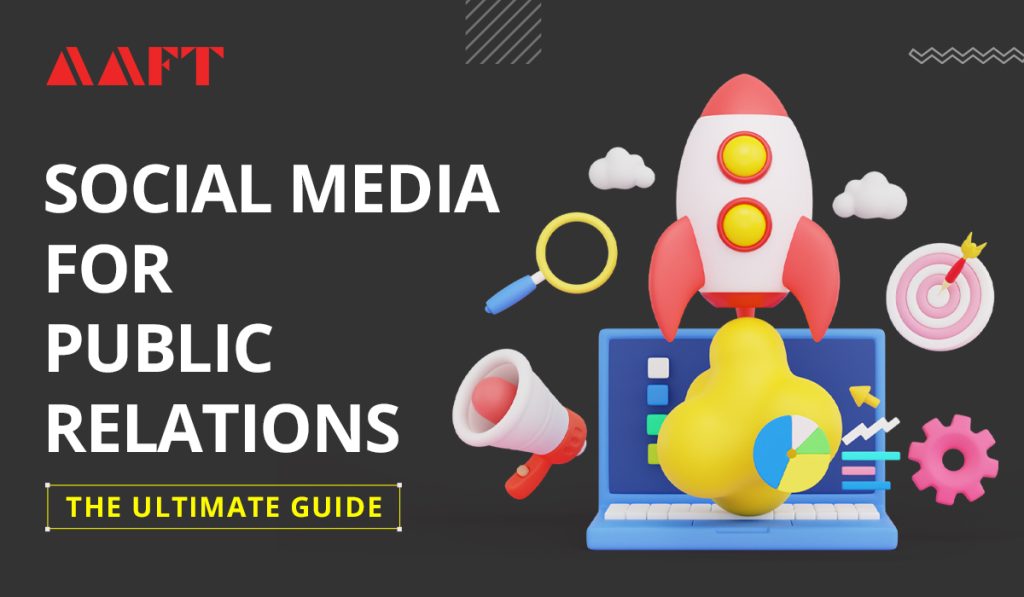Social Media for Public Relations: The Ultimate Guide
This blog introduces the transformative role of social media in modern public relations, highlighting its power, challenges, and the need for strategic storytelling while emphasizing ethical responsibilities.
How to use social media for public relations?
What is Public Relations?
Public relations (PR) is the strategic communication practice that aims to build and maintain positive relationships between organizations, individuals, or entities and their target audiences. It involves managing perceptions, reputation, and public image through various communication channels.
What is social media?
Social media comprises online platforms and technologies that facilitate the creation, sharing, and exchange of user-generated content. It allows individuals and organizations to connect, engage, and interact with a global audience in real-time.
How can social media be used for public relations?
Do you want free career counseling?
Ignite Your Ambitions- Seize the Opportunity for a Free Career Counseling Session.
- 30+ Years in Education
- 250+ Faculties
- 30K+ Alumni Network
- 10th in World Ranking
- 1000+ Celebrity
- 120+ Countries Students Enrolled
Social media marketing serves as a powerful tool for public relations by enabling organizations to disseminate information, engage with their audience, address concerns, and manage their reputation effectively. It offers a direct, immediate, and interactive channel for communication, storytelling, and brand promotion.
Social media platforms provide a global platform for showcasing your brand’s demeanor, values, and offerings. Regular, compelling content can help your brand reach a wider audience, thereby increasing its recognition and memorability. Consistent brand exposure inspires confidence and brand loyalty.
1. Enhanced Customer Loyalty:
Social media enables direct, real-time communication with your audience. Humanize your brand by engaging with comments, messages, and discussions. Responding to customer comments, questions, and concerns demonstrates receptivity and concern, thereby strengthening customer engagement..
2. Enhanced Reputation Management:
Social media serves as a rapid-response channel for administering the reputation of your brand. This is part of reputation management. Quickly and openly addressing issues or negative feedback can mitigate damage and preserve a positive image. Positive interactions and testimonials also contribute to a favorable reputation.
3. Increased Website Visitation:
Sharing valuable content, such as blog posts, videos, and infographics, on social media can increase website traffic. By including links in your posts, you direct users who are interested in learning more about your products or services to your website.
4. Generated Sales and Leads:
Social media can be an effective instrument for generating leads. Attractive content and targeted advertising can encourage potential consumers to investigate your offerings. Through strategic campaigns, it is possible to convert these leads into transactions and thereby increase revenue.
Do you want free career counseling?
Ignite Your Ambitions- Seize the Opportunity for a Free Career Counseling Session.5. Data-Informed Insights:
Social media platforms offer analytics tools that provide valuable insights into the behavior and preferences of your audience. These statistics can inform your public relations strategies, allowing you to modify your content and engagement efforts for improved results.
6. Effective advertising:
Social media marketing is frequently a more economical alternative to conventional advertising. Paid social media campaigns can be precisely targeted to your ideal audience, maximizing the effectiveness of your marketing budget.
7. Real-Time Trend Analysis:
Social media enables public relations professionals to monitor real-time conversations and trends. This awareness can inform your PR strategies and content creation, ensuring that your messaging is in line with current events and discussions.
The Different ways to use Social media for Public Relations:
1. Share Company News and Updates
Social media platforms are instantaneous channels for disseminating company news and updates. If you are announcing product launches, highlighting accomplishments, or sharing corporate social responsibility initiatives, these platforms enable you to reach a large audience quickly and effectively.
2. Conduct Contests and Gift-Giving:
Contests and giveaways may attract interest and participation. Encourage user participation by requesting that they share your content, tag peers, or generate brand-related user-generated content. This not only increases your brand’s visibility but also fosters a sense of community and enthusiasm.
3. Host Question and Answer Sessions with Employees or Executives:
Personalize your brand by hosting live or scheduled Q&A sessions with employees or executives. It enables the public to engage with the people behind the business, relating to your brand and fostering trust. It’s also a great opportunity to answer questions and exchange ideas.
4. Market Your Goods and Services:
Social media is a platform for creatively showcasing your products or services. Utilize high-quality images, videos, and persuasive text to emphasize their features, benefits, and value propositions. Paid advertising may address specific demographics in order to maximize exposure and conversions.
5. Collaborations- Influencer Marketing:
PR efforts can be amplified by collaborating with influencers who align with your brand’s values and target audience. This is part of influencer marketing. Influencers can authentically endorse your products or services, providing their followers with a reliable recommendation. Ensure that the partnership feels authentic and not excessively promotional.
6. Responding to Customer Comments: Brand Awareness
Social media are a bidirectional communication channel. Actively interact with your audience by replying to their comments, messages, and reviews. Responding promptly and professionally to both positive and negative feedback demonstrates your dedication to customer engagement satisfaction and brand integrity.
Read Also: Tips for Creating A Winning Brand Communication Strategy
7. Crisis Administration and Problem Solving:
Frequently, the first platform where issues and crises emerge is social media. These platforms can be utilized by PR professionals to openly acknowledge and address problems. Providing expeditious and accurate information demonstrates your commitment to resolving issues by aiding in crisis management.
8. Sharing Content and Thought Leadership: Brand Awareness
Share insightful blog posts, articles, infographics, and industry insights on your social media channels. Position your brand as an industry thought leader by providing informative and engaging content to your audience. This enhances your credibility and reputation.
9. Employee Advocacy Applications:
Motivate employees to become social media brand advocates. They can share company news, employment opportunities, and their personal experiences, thus broadening your reach to their networks and humanizing your PR efforts.
10. Community Development:
Create and maintain an online community for your brand. Engage your followers in discussions, polls, and surveys to cultivate a sense of belonging. A devoted and active community can become your brand’s most ardent supporters.
Read Also: The Psychology of Celebrity Endorsements: Why We Trust Famous Faces
The Importance of Having a Social Media Strategy:
1. Write down your goals:
Setting clear goals is the first step in making a social media plan. In other words, these goals are the building blocks of your whole plan.
- Progress That Can Be Measured: Setting goals is a good way to keep track of your social media work. They help you keep track of your progress and judge how well you’ve done over time. For example, if you want to get more people to visit your website, you can use analytics tools to see how your social media efforts are doing.
- Focus and Direction: Setting goals helps you stay focused and on track with your social media activities. They help you figure out what’s most important to your business or group. Having clear goals helps make sure that your efforts are in line with your bigger goals, whether they are to raise brand exposure, boost sales, or get customers more involved.
- Adaptability: You can be flexible if your goals are clear. You can change and try new things while keeping your main goals in mind if you find that a certain plan isn’t working.
2. Figure out who you want to reach:
To make a good social media strategy, you need to know who your target audience is. This is why it’s important:
- Relevance: You can make content and messages that resonate with your audience if you know their demographics, hobbies, and habits. This makes it more likely that people will connect and interact positively.
- Efficient Resource Allocation: Figuring out who you’re trying to reach will help you use your resources more wisely. You can focus on the platforms and kinds of content that your audience is most likely to use and be interested in.
- Personalization: You can make your material feel more personalized by making it fit the tastes of your audience. Brands that give people content that feels like it fits their wants and interests are more likely to get people to interact with and follow them.
Read Also: Why Traditional Ads Still Capture Our Attention
3. Pick the Right Social Media Sites:
There are different kinds of social media sites, and not all of them will work for your viewers and goals.
- Resource Optimization: Each social media site needs time, work, and maybe even money to run ads. You can be sure that your resources will be put to the best use if you choose the right sites. For example, a business-to-business (B2B) company might find that LinkedIn is better for getting leads than Instagram.
- Reaching an Audience: Different platforms attract users from different groups and with different habits. Knowing who you want to reach helps you choose the platforms they use, so you can have the most effect and reach.
- Appropriateness of the material: Different types of material work better on different platforms. Visual material does well on Instagram and Pinterest, for example, while longer pieces of writing might do well on LinkedIn or Medium.
The Do’s and Don’ts’ of Using Social Media for Public Relations:
To-Dos:
1. Be Honest and Open:
- Being honest and open with your audience builds trust. Share real, honest material that fits with the values and mission of your brand.
- Share user-generated material, behind-the-scenes looks, and stories that make your brand seem more real. Talk about problems and issues openly, and when you need to, take the blame.
Read Also: How Can Small Businesses Compete with Big Brands in Advertising?
2. Be Regular and On Time:
- Posting regularly and responding to comments and messages on time show that you are reliable and professional.
- Make a content calendar to keep up with regular sharing times. Keep an eye on social media to see how active people are, and answer questions or comments quickly.
Don’ts:
1. Do not send spam to people:
- Too many posts, the same content, and hashtags can annoy your followers and hurt the picture of your brand.
- Don’t post too much, use hashtags sparingly, and divide your audience into groups so you can send appropriate content to each one.
2. Don’t Post Anything That Could Hurt Your Reputation:
- Both good and bad words can spread quickly on social media. Your brand’s image could be hurt by posting hurtful, offensive, or controversial content.
- Before posting, read the content carefully and think about how it might be interpreted and how people might respond to it. Make clear rules for your team to follow on social media.
3. Do not ignore criticism or negative feedback:
- Ignoring negative comments can make things worse and give the impression that you don’t care. Responding to feedback shows that you want to get better.
- Respond to mean statements in a professional and polite way. Take a moment to understand the concerns, offer solutions or explanations, and if necessary, move the talk offline.
4. Monitoring and analytics shouldn’t be ignored:
- If you don’t keep track of performance and audience sentiment, you might miss chances or leave problems unattended.
- Track key performance factors, keep an eye on engagement, and learn more about how your audience acts by using social media analytics tools. Review your strategy often and make changes based on the facts.
5. Don’t push too hard or promote too much:
- Sending sales texts all the time can turn off followers. Not only can you make sales on social media, but you can also build relationships.
- Mix advertising content with posts that are useful, fun, or educational. Instead of trying to sell your products or services, focus on giving your viewers something of value.
Conclusion
Since social media for PR is always changing, it’s important to keep track of how well your efforts are doing. Following website traffic can help you measuring the success of social media campaigns are at getting people to your online platforms. By keeping an eye on social media mentions, you can find out how people feel about your company and how much they know about it. Looking at data on engagement can also help you figure out how well your content connects with those who read it.
Read Also: Introduction to PR and Successful Campaign
When we look to the future, the use of social media in public relations looks very promising. With the rise of live video, there are more chances to connect with viewers and tell stories in real-time. AI is about to change the way data is processed, which will make PR campaigns more targeted and effective. As data analytics becomes more important, it will allow PR professionals to make decisions based on data, which will help their campaigns stay successful and relevant in a digital world that is changing quickly.
With AAFT, learn more about Social Media’s influence and usage in Public Relations. We offer Bachelor; Master and Diploma programmes within the School of Advertising. To keep learning about informative topics related to advertising subscribe to our blog.








